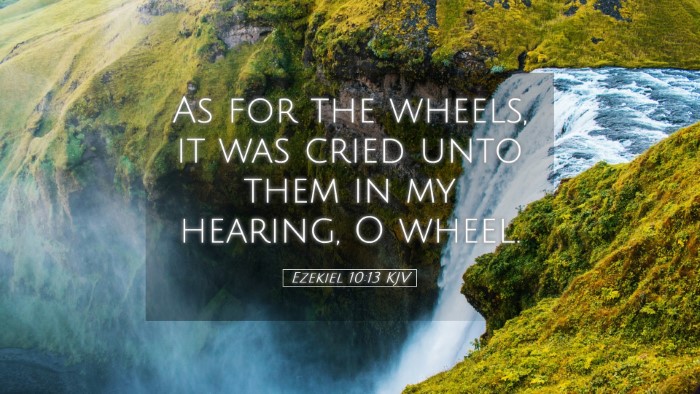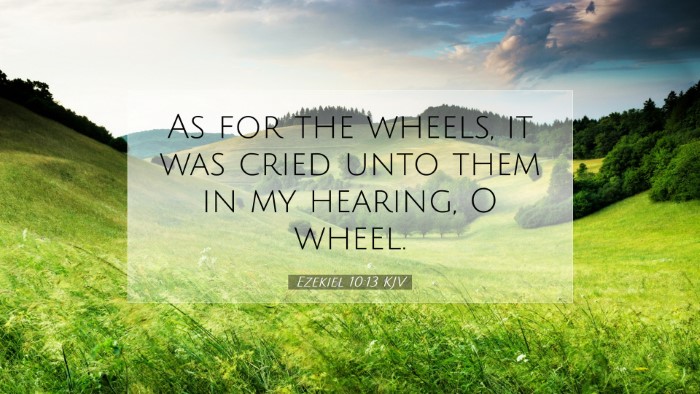Ezekiel 10:13 Commentary
Bible Verse: Ezekiel 10:13 - "As for the wheels, they were called in my hearing, 'the wheelwork'."
Interpretative Overview
The reference to "the wheels" in Ezekiel 10:13 points to a profound element of the heavenly vision that Ezekiel experiences. The term "wheelwork" draws attention not only to the mechanical aspect of the divine chariot but also signifies a symbol of God's sovereign providence and movement in the world.
Historical Context
In the context of the Babylonian exile, Ezekiel's visions reflect the judgment and glory of God amidst a seemingly chaotic situation for the Israelites. The imagery of wheels suggests a dynamic presence of God that is not confined to the temple in Jerusalem but is present even in the exile.
Commentary Insights
Matthew Henry
Matthew Henry reflects on the wheels as symbolic of the providential workings of God. He notes that the "wheel within a wheel" indicates the complexity and depth of God's governing authority over creation. This imagery serves to remind the believer that God is actively involved in the affairs of mankind, even in times of judgment.
- God's Sovereignty: Henry emphasizes the sovereignty of God, asserting that these wheels demonstrate His omnipresence and omnipotence. They are indicative of the divine ability to execute judgment and mercy alike.
- Movement and Action: The interaction of wheels suggests motion and the ongoing activity of God in history. God is not static; He moves and acts in accordance with His will.
Albert Barnes
Albert Barnes elaborates on the technical details of the wheels described in Ezekiel’s vision. He interprets the term "wheelwork" as indicative of both divine function and purpose.
- Symbolic Representation: Barnes suggests that the wheels can be seen as symbols of the divine will orchestrating events on earth. They visually represent the harmony and order inherent in God's creation and governance.
- Functional Dynamics: He argues that the design of the wheels implies an intricate connection between heaven and earth, bridging the gap between divine authority and earthly existence.
Adam Clarke
Adam Clarke provides a more elaborate treatise on the functionalities of the wheels, drawing parallels to other biblical descriptions. He reflects on how these wheels have often been interpreted within the framework of systems of faith.
- Spiritual Hierarchy: Clarke posits that the wheels may represent various levels of spiritual authority, indicating that divine judgment involves multiple layers of decision-making in heavenly realms.
- Movement in Unity: He notes that the wheels’ ability to move in unison portrays a unity in divine purpose which encourages believers to discern the larger plans of God even when circumstances appear confusing or overwhelming.
Theological Implications
Several theological themes emerge from the interpretation of Ezekiel 10:13:
- The Omnipresence of God: The wheels signify that God's presence fills all space and time; He is everywhere, unhindered by physical limitations.
- Divine Judgment and Mercy: The movement of the wheels may also symbolize the duality of God's nature, where judgment and mercy coexist and unfold in human history.
- Encouragement in Exile: For the exiled Israelites, these images served to remind them that God had not abandoned them; He was actively working for their eventual restoration.
Practical Applications for Ministry
In light of Ezekiel 10:13 and the insights drawn from various commentators, pastors, students, and theologians can meditate upon several applicable points:
- Assurance of God's Sovereignty: In ministry, it is essential to teach about God’s sovereign control over all aspects of life, reminding congregants that God orchestrates both trials and triumphs.
- Encouraging Faithfulness: Ezekiel's vision encourages faithfulness during difficult times, urging believers to maintain trust in God’s ultimate plan.
- Active Discernment: Just as Ezekiel was called to discern the meanings behind the visions, so too should ministry leaders encourage congregants to seek understanding in their own spiritual journeys.
Conclusion
Ezekiel 10:13, through the lens of rich commentary from Henry, Barnes, and Clarke, invites believers to appreciate the complexity and magnificence of God's work through the imagery of the wheels. It is a call to recognize God's active presence in the world, His sovereign will amid chaos, and the assurance that He is ever guiding His people towards redemption.


